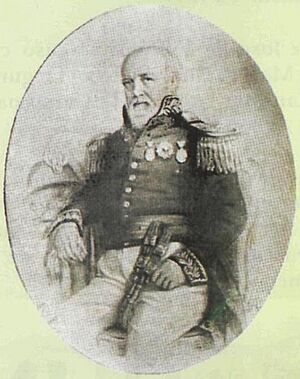José de Villamil facts for kids
José de Villamil (1789–1866) was born in New Orleans when Louisiana was a Spanish colony. He was a key figure in the independence of Ecuador. He helped create Ecuador's navy and was the first Governor of the Galápagos Islands. He also served as Minister of Foreign Relations. The city of General Villamil Playas is named in his honor. José de Villamil was the younger brother of Felipe Martin de Villamil.
In 1803, Louisiana was sold to the United States. In 1804, Villamil became a Cadet and later a Sergeant in the "Company of Rifles volunteers Louisiana." In 1810, he traveled to Spain. There, he met important people and joined a secret group called the "Lautaro" Masonic Lodge. He promised to support the independence of American countries from Spain.
He then went to Maracaibo, Venezuela. He wrote letters supporting the revolution, which were found by the Governor. He was almost executed but managed to escape thanks to his connections.
In 1811, he was in Guayaquil, Ecuador, working in trade and earning a lot of money. In 1813, he traveled to the United States. He bought a ship called "Alcance" and brought weapons back to sell. That same year, he married Ana Garaycoa Llaguno.
Fighting for Independence
In 1815, while on a business trip to Haiti, Villamil met Simón Bolívar. Bolívar was a famous leader who wanted to free South America from Spanish rule. He asked Villamil to join the fight.
On February 8, 1816, Villamil and his family were sailing near Guayaquil. They saw enemy ships. Villamil quickly warned the city of the danger. He helped defend Guayaquil when the enemy fleet attacked. The people of Guayaquil won the battle. They captured the enemy captain, Guillermo Brown, who was actually sent by another revolutionary group to help Guayaquil gain independence. Villamil acted as a translator and learned about their true mission.
In 1818, he lived in Lima, Peru, and secretly worked for independence.
On October 1, 1820, Villamil organized a dance at his house in Guayaquil. This was a secret meeting to plan a revolution against Spanish rule. On October 7, the plotters decided to act quickly because the authorities were becoming suspicious. In the early hours of October 9, Guayaquil became free from Spain. Villamil was celebrated as a main leader of the revolution, along with Venezuelan officers Luis Urdaneta and León de Febres Cordero. His wife made the blue and white flag of Guayaquil and waved it from their balcony.
On October 14, Villamil was sent to find Lord Cochrane and his fleet. He found them on October 31. The next day, he met Libertador San Martín, another important independence leader. San Martín made him a Lieutenant Colonel and gave him an award. Villamil returned with 150 rifles. He also received a medal and the title of Lieutenant Colonel in November.
Later, he led a group of soldiers to fight against the Spanish. He also helped defend Guayaquil when some ships rebelled. He traveled to Panama to bring more soldiers who would fight in the important Battle of Pichincha.
In 1822, he became good friends with Simón Bolívar. After the Battle of Pichincha, Villamil was promoted to Colonel.
Life After the War
In 1824, Villamil tried to bring water to the city of Guayaquil, but the plan did not work out. In 1828, he helped defend Guayaquil from a Peruvian attack. He was taken prisoner for a short time. Between 1829 and 1830, he was the head of the city's government.
In October 1831, Villamil sent a group to explore the Galápagos Islands. He wanted to find a plant called orchilla, which was used for dyeing fabrics. On November 14, he started a group called the "Colonizing Society of the Galapagos Archipelago." He claimed Charles Island, now called Floreana, as empty land. In December, he joined a revolution and became the Commander of Arms of Guayaquil.
In January 1832, he created a group of soldiers to fight against an attacking army. On January 20, an expedition to the Galápagos Islands set off. In 1833, he was the United States Consul General in Guayaquil for a few months. He then traveled to the Galápagos as the Governor of the Archipelago. He managed the islands very well.
The ship HMS Beagle arrived in the Galápagos on September 15, 1835. On board were Captain Robert FitzRoy and the young naturalist Charles Darwin. They studied the islands' geology and animals. Darwin's observations of the unique plants and animals helped him develop his famous theory of the origin of the species.
Villamil resigned as Governor of the Galápagos in 1837 because fewer people were living there. He left General Pedro Mena in charge of his property. In 1841, he returned to military service. He went back to the Galápagos and moved his cattle to avoid problems with the settlers.
In August 1842, while in the Galápagos, he learned about a yellow fever outbreak in Panama. He quickly sailed to Guayaquil to warn everyone. He wanted ships from the north to be quarantined (kept separate) to stop the disease from spreading. However, it was too late, as infected ships had already arrived.
After a revolution on March 6, 1845, Villamil was sent to convince the Governor of Manabí to support the new movement. He returned to Guayaquil with a group of revolutionaries.
Villamil wrote a report about the Galápagos Islands. He described the pleasant temperature, good water, and fertile land. He believed the islands could support many people. He mentioned that there were 48 cultivated plots and 51 cabins, with about 400 people living there. He also noted a road and a water spring. However, he also said that after 1833, when criminals were sent to the Galápagos, the colony became a dangerous place.
He continued to serve his country. He was promoted to General of the Republic.
See also
 In Spanish: José de Villamil para niños
In Spanish: José de Villamil para niños
- Ana Villamil Icaza


